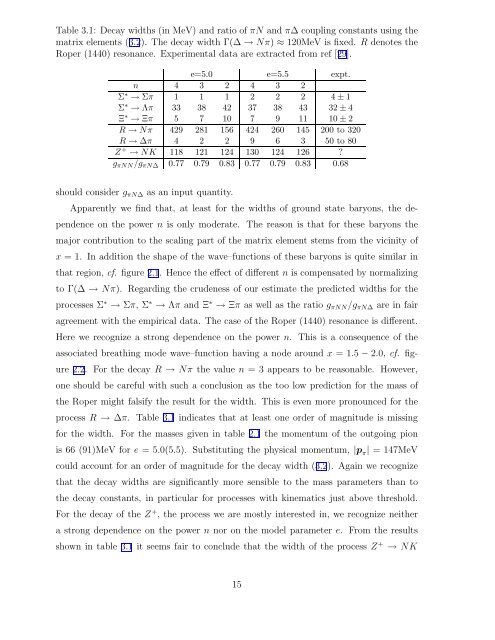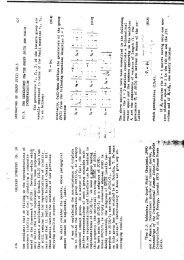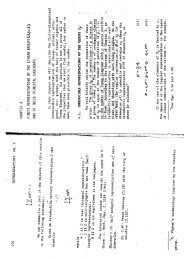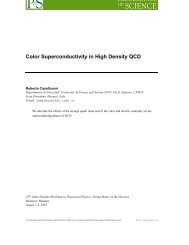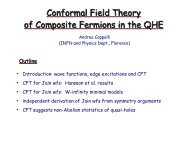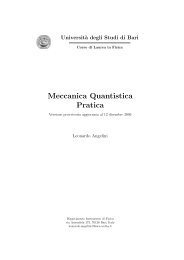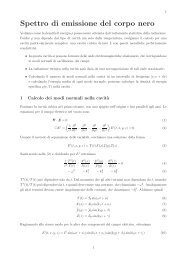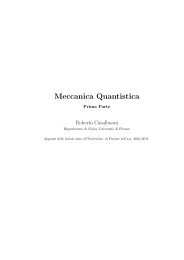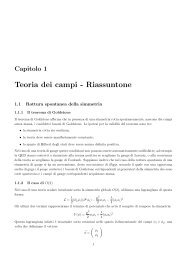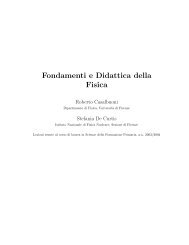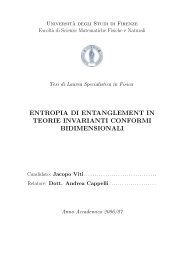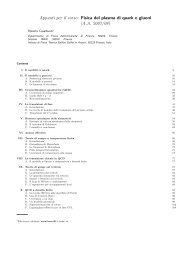arXiv:hep-ph/9804260 v2 16 Jun 1998 - Florence Theory Group
arXiv:hep-ph/9804260 v2 16 Jun 1998 - Florence Theory Group
arXiv:hep-ph/9804260 v2 16 Jun 1998 - Florence Theory Group
Create successful ePaper yourself
Turn your PDF publications into a flip-book with our unique Google optimized e-Paper software.
Table 3.1: Decay widths (in MeV) and ratio of πN and π∆ coupling constants using the<br />
matrix elements (3.2). The decay width Γ(∆ → Nπ) ≈ 120MeV is fixed. R denotes the<br />
Roper (1440) resonance. Experimental data are extracted from ref [29].<br />
e=5.0 e=5.5 expt.<br />
n 4 3 2 4 3 2<br />
Σ ∗ → Σπ 1 1 1 2 2 2 4 ± 1<br />
Σ ∗ → Λπ 33 38 42 37 38 43 32 ± 4<br />
Ξ ∗ → Ξπ 5 7 10 7 9 11 10 ± 2<br />
R → Nπ 429 281 156 424 260 145 200 to 320<br />
R → ∆π 4 2 2 9 6 3 50 to 80<br />
Z + → NK 118 121 124 130 124 126 ?<br />
gπNN/gπN∆ 0.77 0.79 0.83 0.77 0.79 0.83 0.68<br />
should consider gπN∆ as an input quantity.<br />
Apparently we find that, at least for the widths of ground state baryons, the de-<br />
pendence on the power n is only moderate. The reason is that for these baryons the<br />
major contribution to the scaling part of the matrix element stems from the vicinity of<br />
x = 1. In addition the shape of the wave–functions of these baryons is quite similar in<br />
that region, cf. figure 2.1. Hence the effect of different n is compensated by normalizing<br />
to Γ(∆ → Nπ). Regarding the crudeness of our estimate the predicted widths for the<br />
processes Σ ∗ → Σπ, Σ ∗ → Λπ and Ξ ∗ → Ξπ as well as the ratio gπNN/gπN∆ are in fair<br />
agreement with the empirical data. The case of the Roper (1440) resonance is different.<br />
Here we recognize a strong dependence on the power n. This is a consequence of the<br />
associated breathing mode wave–function having a node around x = 1.5 − 2.0, cf. fig-<br />
ure 2.2. For the decay R → Nπ the value n = 3 appears to be reasonable. However,<br />
one should be careful with such a conclusion as the too low prediction for the mass of<br />
the Roper might falsify the result for the width. This is even more pronounced for the<br />
process R → ∆π. Table 3.1 indicates that at least one order of magnitude is missing<br />
for the width. For the masses given in table 2.1 the momentum of the outgoing pion<br />
is 66 (91)MeV for e = 5.0(5.5). Substituting the <strong>ph</strong>ysical momentum, |p π| = 147MeV<br />
could account for an order of magnitude for the decay width (3.2). Again we recognize<br />
that the decay widths are significantly more sensible to the mass parameters than to<br />
the decay constants, in particular for processes with kinematics just above threshold.<br />
For the decay of the Z + , the process we are mostly interested in, we recognize neither<br />
a strong dependence on the power n nor on the model parameter e. From the results<br />
shown in table 3.1 it seems fair to conclude that the width of the process Z + → NK<br />
15


